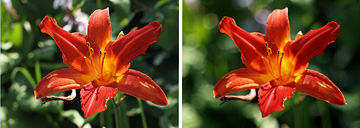Keeping things unfocused, as in photography, so in life
Guest Column by James Harbeck
COFFEE WITH WARREN, with Warren Harbeck
Cochrane Eagle, September 5, 2012

A lily bursts forth from its garden, with different degrees of background blur demonstrating bokeh.
Photos by James Harbeck
This is the first of two guest columns by my sons, Reg Harbeck, a Calgary-based computer philosopher, and James Harbeck, a Toronto-based writer/editor.
This week’s column is by James, who, in addition to his literary work, is also a designer, avid photographer, and creator of the popular blog for lovers of the English language, Word Tasting Notes. Here, James brings together his photographic and linguistic passions.
___
I was out at the country place of a friend this past July, near Owen Sound, Ontario. The house is lovely, and it has a pretty property, including a charming little garden. Naturally, I brought my camera.
There are different ways to photograph a garden. You can take a picture of the whole garden in its context. You can photograph part of it, just a nice arrangement of botany, bouquets in the wild. Or you can photograph one thing – a flower, for instance. I wandered through the garden, doing a bit of each, and a flower caught my eye.
I came up close to make the flower the centre of attention, with the greenery behind it a supporting cast – perhaps a chorus line, or perhaps even just extras in a crowd.
I clicked. I looked at the results on my digital camera’s screen. I decided I wanted a different amount of blurring the background. I adjusted the aperture on my lens and clicked again. You can see the two results in my two pictures accompanying this column.
Photographs have that feature that we’re little used to when we look with our eyes, a feature that never showed up in the visual arts until photography introduced it: things that aren’t the centre of attention can be out of focus. Blurry.
What makes the background (and foreground) more or less blurry is an effect caused by the width of the aperture (the opening in the lens the light passes through).
Something that would be a single point of light in focus is a circle when out of focus, and the size of the aperture – and how far out of focus the point is – will determine how big that circle is. The circle is called a circle of confusion. Put all those circles of confusion together and you have a blur.
That sounds like real life, doesn’t it? Things that aren’t what we are focusing on, that aren’t on the point, are a bit of a blur for us – they’re in circles of confusion. They’re like so much background noise. How much they factor in at all depends on how focused we are – and perhaps how wide-eyed we are.
But that’s not necessarily a bad thing, in real life or in photography. In a noisy room, you want the voice of the person you’re listening to to stand out. In ideas, you want the important one to blossom forth more clearly. In a photograph, you want a suggestion of the background, but you don’t always want it so sharp it distracts.
But not all blurs are equally nice. Different lenses produce different kinds of circles of confusion: some have sharper edges, some have softer ones; some are really polygons. Some blurs are less smooth or less blended than others.
There’s a word for the out-of-focus part of a photograph: bokeh, which comes from Japanese for “blur” or “haze.” It’s not just about how blurry the area is. It’s about how smooth the blur is. If a photograph were a glass of wine, the quality of the unfocused areas would be its “bouquet.”
It makes a difference, just as it makes a difference how much and what kind of noise you have to ignore in a busy room, or how well the related ideas you’re not focusing on at the moment blend together to work with the one that is central. Not just how you’re focused but also how you’re unfocused can help determine if it will be OK.
Bokeh. Such a hard word for a soft thing. Well, taste does come into these things. Different people like different effects. Which of the two flower photos do you prefer?
© 2012 James Harbeck
JoinMe@coffeewithwarren.com